There are a variety of processes and techniques a painting company uses to ensure high-quality results that enhance aesthetics and durability in various spaces. Learn more about these professional approaches.
Preparing the Surfaces
Understanding the preparation process is crucial for achieving beautiful results in painting projects. Surface preparation is a foundational step that dictates the final appearance and longevity of the paint job.
Professional painters typically start by cleaning the surface thoroughly to remove dirt, grease, and mildew. This may involve power washing or using chemical cleaners designed for the specific surface material.
Next, any imperfections such as cracks, holes, or peeling paint must be addressed. Filling in gaps with appropriate fillers ensures a smooth base for paint application. Moreover, sanding the surface to create an even texture is essential for proper adhesion of the paint.
Finally, priming the surface with a suitable primer is crucial, especially for porous or raw materials. Primer acts as a bonding agent that enhances the paint’s adherence while ensuring uniformity in color and finish. Skipping this crucial step can lead to subpar results and early degradation of the paint job.
Choosing the Paint Type
The choice of paint can significantly influence the appearance and longevity of the finish. When selecting paint for various surfaces, it’s important to consider the material and environmental conditions. For instance, latex paints are widely used for interior walls due to their durability and ease of cleaning, while oil-based paints are often preferred for trim and molding because of their smooth finish and hardening properties.
Additionally, the sheen level of the paint plays a vital role in the outcome. Flat or matte finishes can help disguise wall imperfections, while eggshell and satin finishes are easier to clean and more resistant to moisture. In high-traffic areas, semi-gloss and gloss paints are recommended due to their durability and washability.
Furthermore, specialized paints exist for unique applications. For instance, anti-mold paints are ideal for damp environments such as bathrooms and basements. Similarly, exterior paints are formulated to withstand UV rays and harsh weather, ensuring a long-lasting and vibrant finish that enhances curb appeal.
Applying the Paint
Professional painters employ specific methods and tools to uphold cleanliness and precision during the painting process. Preparation is key to achieving a clean application. Professional painters meticulously cover any adjacent areas with drop cloths or masking tape to prevent overspray and drips. This attention to detail helps maintain a professional appearance, avoiding costly cleanup later on.
The tools used in the painting process also make a significant difference. High-quality brushes and rollers ensure even application without leaving behind streaks or brush marks. Additionally, sprayers can be used for larger areas, offering an even coat while minimizing the risk of spills.
Moreover, maintaining a tidy workspace is critical during the painting process. Painters often take regular breaks to clean tools and tidy up around the work area. This not only enhances efficiency but also creates a safer environment, reducing the risk of accidents and ensuring impressive results without unsightly messes.
Selecting the Colors
The impact of color choice goes beyond aesthetics, affecting mood and space perception. Color selection can dramatically alter the ambiance of a room. Lighter tones can make a space feel larger and more inviting, while darker shades can create a cozy and intimate atmosphere. Understanding color psychology can help homeowners select hues that resonate with their personal preferences and the intended use of the space.
Furthermore, the undertones in colors can shift the space’s perceived characteristics. For instance, warm tones like reds and yellows tend to evoke feelings of warmth and comfort. Conversely, cool tones like blues and greens are often associated with tranquility and relaxation, making them ideal for bedrooms or study areas.
Professional painting companies often provide color consultation services to assist clients in making informed decisions. By showcasing color samples and offering guidance based on current trends and design principles, they help clients envision the final outcome and feel confident in their choices.
Maintaining the Surfaces
Proper maintenance tips can prolong the life of painted surfaces and keep them looking fresh. One of the simplest yet most effective ways to maintain painted surfaces is through regular cleaning. Using mild soap and water, homeowners can wipe down walls and surfaces to remove dust and grime that accumulates over time. Avoiding harsh chemicals is crucial, as these can damage the paint and lead to premature wear.
In addition to cleaning, it’s essential to conduct periodic inspections for any signs of damage, such as chips, peeling, or discoloration. Addressing these issues promptly can prevent further deterioration and maintain the integrity of the paint job. Simple touch-up repairs can often be done with minimal effort and can significantly extend the life of the finish.
Creating an appropriate environment can enhance the durability of painted surfaces. Keeping humidity levels stable and using weatherproof paints for exterior surfaces protects against the elements. Additionally, avoiding direct sunlight on susceptible locations can help prevent fading and discoloration, ensuring that painted surfaces remain vibrant and attractive over time.
A thorough understanding of how painting companies work can empower homeowners to achieve stunning results in their own painting projects. Knowledge of surface preparation, paint selection, application techniques, color theory, and maintenance can make a significant difference in transforming a space. By applying these insights, homeowners can enjoy beautiful and durable finishes that enhance their living environments.

